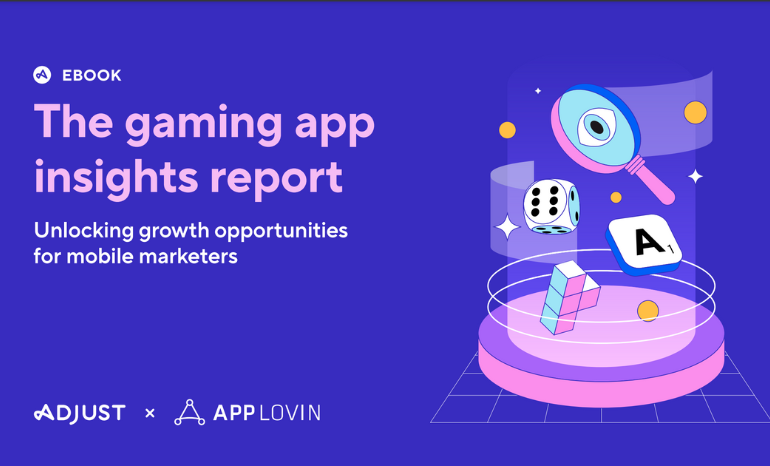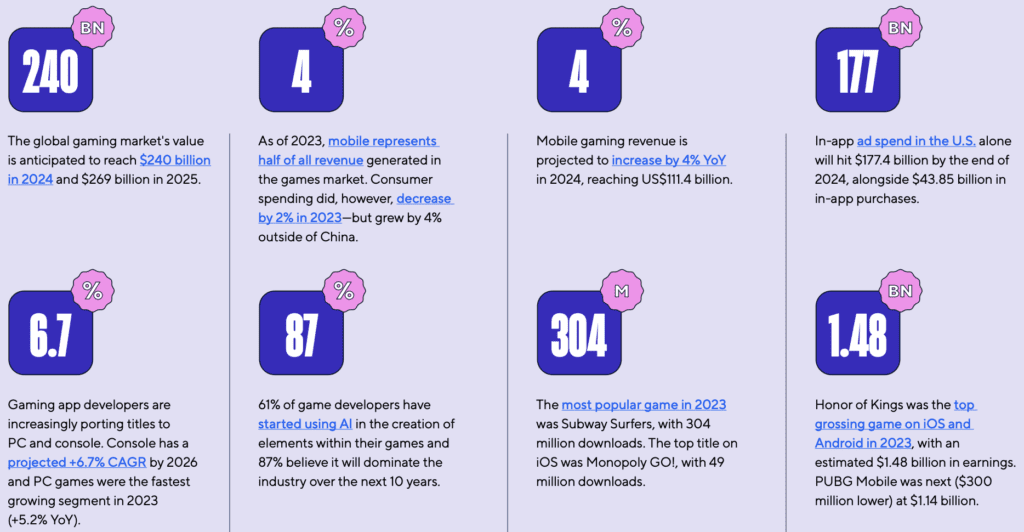
AppLovin & Adjust: 2024 Gaming App Insights
Journal 72 Ömer Yakabagi March 29
We all know that nobody likes 1000-words articles, but this one worths it!
Let’s take a deep dive into Adjust data and hear from AppLovin and SparkLabs for expert insights on implementing the right marketing mix and activating the right channels, leveraging CTV for maximum impact, and creating high-quality creatives at scale.

State of Play on the Mobile Games Market
Gaming app installs and sessions faced challenges in 2023, with a 2% decrease in installs and a 7% drop in sessions. However, there’s a positive shift in Q4 2023, with installs increasing by 7%, a trend expected to continue. Sessions in Jan’24 rose by 3% compared to Jan’23.
While LATAM was the only region with YoY growth in 2023, Q4 showed significant improvement. APAC saw a 3% increase in YoY installs, EMEA rose by 12%, North America by 6%, and LATAM continued its upward trend with a 19% YoY jump in Q4.

Key Takeaways
- Gaming app installs grew 7% YoY in Q4 of 2023 and sessions are up 3% in January 2024
- Racing Installs grew by 61%, simulation by 53%, and arcade by 38%.
- Arcade Sessions increased by 19%, adventure by 7%, and simulation by 6%
- Hybrid Casual games’ median D1 Retention rate is 29%, and it’s 27% for Hypercasual
- US has the highest CPM of any market globally at $15.86, followed by Japan at $7
- The longest gaming app session lengths regionally take place in APAC at 35 minutes per session. Indonesia has the longest sessions as an individual country – 48 minutes.


Action Games Dominate Installs and Sessions
Action games led in app installs at 18%, followed by hyper-casual and puzzle games (14% each), casual games (9%), and simulation games (7%). On Sessions, action games dominated with 27%, followed by sports and puzzle games (both 12%), board games (7%), casual games (6%), and hyper-casual and RPG games (both 5%).

Gaming App Growth: Singapore Tops Installs, Mixed Trends in Sessions
Notable YoY growth in gaming app installs was observed in Singapore (9%), the Philippines (6%), and Mexico (5%). Meanwhile, South Korea experienced a 2% increase in sessions, but Singapore saw a significant 37% decline compared to 2022. Despite mixed overall numbers, certain subverticals thrived. Racing installs surged by 61%, simulation by 53%, and arcade by 38%. Arcade games also saw a robust 19% increase in sessions, followed by adventure (7%) and simulation (6%).


Organic Installs Dip: APAC Tops, Singapore Leads by Country
From 2022 to 2023, organic installs for gaming apps fell from 57% to an even 50%, signaling a drop in organic interest. Word and strategy games bucked the trend, increasing their organic share to 44% and 65%, respectively. However, arcade games saw the largest decline, dropping from 49% to 39% in organic installs.
APAC led with 48% organic installs, followed by EMEA at 41%, North America at 36%, and LATAM at 33%. Singapore boasted the highest organic share by country at 38%, followed closely by the US, Indonesia, and Japan, all at 35%.

Session Lengths by Region: APAC Leads, Action Tops Verticals
APAC recorded the longest session lengths at 35 minutes, followed by EMEA (29), LATAM (27), and North America (25). Indonesia topped individual countries at 48 minutes, trailed by the Philippines at 46. Conversely, the UK and Ireland had the shortest sessions at 24 minutes.
Across verticals, action maintained the longest sessions in both 2022 and 2023, slightly decreasing from 45.8 to 45.7 minutes. Adventure increased from 28.8 to 29.7 minutes, hyper casual surged from 14 to 16.4 minutes, and RPG dropped from 41.5 to 40.4 minutes.


Global Retention Trends: APAC Leads in Day 1 Rates
Global D1 median retention rate for gaming apps dipped from 29% to 28.3%. Across subverticals, retention rates varied. Notably, hybrid casual surpassed the global median at 29%, outstripping hyper casual by two percentage points. Sports boasted the highest rate at 31%, followed closely by casino, puzzle, RPG, and simulation, all at 30%.
APAC stood out as the only region to surpass the global median with a day 1 rate of 29%. Notable countries such as Indonesia, India, Japan, and Singapore shared this rate, while EMEA, LATAM, and Mexico reached 28%. Conversely, South Korea, the UAE, and Brazil recorded a lower day 1 rate of 25%.

Global Ad Performance: Hyper Casual Leads the Pack
Hyper casual games boasted the highest IPM at 13.88, followed closely by hybrid casual at 9.03. On the other hand, adventure and RPG genres reported significantly lower IPMs, standing at 1.66 and 1.68, respectively. This discrepancy likely stems from their niche appeal or fewer ad placements.
Certain regions and markets outperformed the global benchmark, with Brazil leading at 7.46, followed by EMEA at 6.67, and India at 6.27. These regions exhibited a higher rate of hyper casual and hybrid casual placements compared to their counterparts with lower IPMs. Conversely, Singapore (2.49), South Korea (4.07), Japan (4.09), Indonesia (4.63), and the DACH countries (3.79) reported lower figures due to a higher prevalence of placements and interest in RPG and adventure titles.


CPI Trends: Surges and Drops Across Genres and Regions
The global median eCPI for gaming apps surged from $0.52 in 2022 to $0.99 in 2023. Among genres, simulation experienced the most significant spike, leaping by $1.23 from $1.45 to $2.68. While hyper casual maintained the lowest cost per install, it also saw a considerable increase from $0.09 to $0.32. Surprisingly, role-playing games slashed their median eCPI by $0.42, dropping from $4.50 to $4.08.
Regional and country-specific CPIs vary widely, influenced largely by the popularity of specific subverticals. Comparing median eCPI to LTV or revenue metrics can unveil promising areas for localization and marketing spend. India boasted the lowest median eCPI at just $0.05 per install, while the U.S. topped the charts at $2.14. Japan followed closely at $1.29, trailed by South Korea ($1.05), and DACH ($0.97).

Advertising Costs: CPM Trends Globally and by Region
Gaming app advertisers face a median CPM of $5.56. Simulation tops the charts as the most expensive subvertical at $6.65, closely followed by word games at $6.09. Surprisingly, hybrid casual ranks next at $6.05, despite its low cost per click, suggesting a high impression-to-ad-spend ratio. Conversely, sports games boast the lowest CPM at $2.25, with casual games following at $3.94.
North America stands out as the priciest market for CPM, with a staggering $15.08, while the U.S. alone hits $15.86. Although returns are higher in this market, the discrepancy with the next costliest market, Japan at $7, is substantial. Given the hefty investment required, marketers must leverage robust analytics to make strategic decisions about scaling and pausing campaigns effectively.

Gaming App Partners – Global & By Region
Globally, gaming apps scaled back their partnerships from an average of 6.5 in 2022 to 6 in 2023, reflecting budget constraints and a potential consolidation of marketing channels to optimize spending. Trivia apps led the pack with the most partners at 10, followed closely by hyper casual games at 9, while adventure games partnered with 8. In contrast, puzzle games saw the fewest partners, dropping from 9 to just 5. To unlock scalable growth, studios should consider reinvesting in activating new channels.
Regionally, LATAM and Turkey boasted the highest median number of partners, both at 6.5. Singapore, France, the UAE, and the U.S. followed suit, each working with 6 partners, aligning with the global median. Conversely, India, Indonesia, and Japan reported the lowest median number of partners, with just 4 in 2023.
Source: Adjust & AppsFlyer







